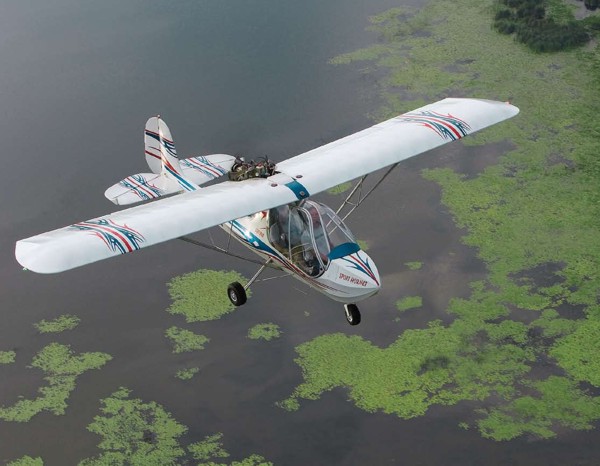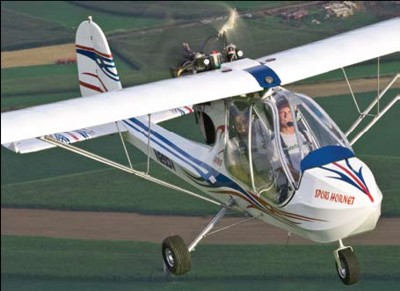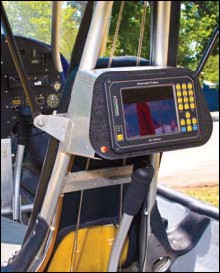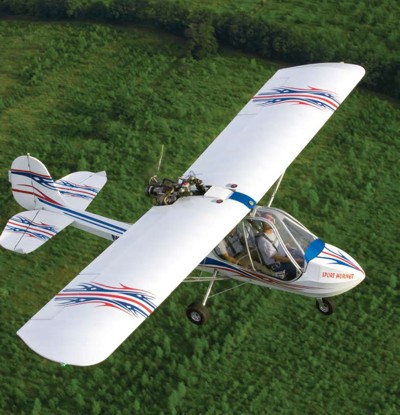


The Sport Hornet’s instrument panel has “grown up” to support the instrumentation
sport pilots may want.

The brainchild of Jim Millett, rubber dampeners
ease the load on the Hornet’s landing gear, all cleverly hidden under the seat.

To aid flight training, Higher Class has
added a mount for an electronic engine
information system and/or electronic
flight information system, so both pilots
are fully informed. Shown here is a
Stratomaster Enigma unit installed in this
owner’s aircraft.

For S-LSA approval, LSA must have a fuel
shut off switch. Higher Class Aviation
mounts it above the front seat, accessible
to both pilot and passenger.

Is It the First Ultralight SLSA?
Among fixed-wing airplanes, the Sport Hornet from Higher Class Aviation
may be the first ultralight-type airplane to achieve special light-sport
aircraft (S-LSA) status. Several weight-shift trikes and a few powered
parachutes also have made the jump, making declarations of meeting the
ASTM industry consensus standards.
As company owner Robert Gaither and his team made the Hornet ready for the
LSA market, the airplane was put through a series of changes resulting in the
name Sport Hornet.
From Hornet to Super Hornet to Sport Hornet
Jim Millett, of U.S. Light Aircraft,
designed the original Hornet thinking
he could improve upon the Quad
City Ultralight’s Challenger. His was
a ground-up different design that had
only the look of a Challenger. Much
of what Jim created remains on the
Sport Hornet of today, but much has
also changed, sometimes to meet
S-LSA requirements and sometimes
because it was the right thing to do.
After Robert bought the company
he made minor changes to the
airplane, but none to Jim’s impressive
airframe design. With pilots asking
for more power, Higher Class added
the Rotax 912 to the airplane, a bigger
than usual challenge owing to the aft
engine placement.
As LSA regulations loomed large
on the planning horizon of all
ultralight companies, Robert chose
to embrace the opportunity. Part of
that was moving to the even-more
powerful Rotax 912S. At that point it
was apparent more extensive changes
would be necessary to support such a
powerful engine. Remember, the first
Hornet flew well with a Rotax 503
with 52 hp.
As Hornet team members worked to
achieve S-LSA status, they knew they’d
have a tail-heavy airplane when they
bolted on the big 912S engine. One
solution was to move the battery to
the farthest forward position possible.
While adding dead weight to
a “light” sport airplane sounds
counterintuitive, the model is
aerodynamically sound without
ballast, assuming a large occupant up
front or with both seats filled. Robert
said, “The majority of our customers
are coming in at 200 to 210 pounds.
Ballasting procedures are used only
when the airplane’s flown solo by
a lightweight pilot. Our aircraft
operating instructions cover this
process in detail.”
In what seems a small change
yet took many engineering hours,
Higher Class engineers widened the
cockpit 4 inches to accommodate its
larger customers. This allowed them
to move the rear rudder pedals up
about 6 inches to allow the rear seat
occupants to wear boots and still work
the pedals. Older Hornets seemed a
bit tight for the aft person’s feet with
some concern of control interference.
Now, the pedals are more accessible.
In a fairly major structural change,
a second wing strut was added to
control wing torsion (twisting)
movements resulting from the
additional power-a requirement
to meet S-LSA standards. Another
driver in this engineering move was
to eventually permit 1,320 pounds of
gross load where early Hornets carried
only 1,000 pounds.
When the strut changes were
made, dihedral was added to the wing
to make for a much more stable flying
aircraft, according to longtime Hornet
enthusiast Roger Chase. The original
wing had almost no dihedral. Despite
the greater stability, Roger says the
airplane lost no performance, and
handling qualities were improved. “I
don’t know why Jim and I didn’t do
this sooner,” he added.
Production S-LSA Sport Hornets
will have a 30-foot wingspan,
differing from the 28-foot span on the
production prototype Sport Hornet I
flew. This change will allow Higher
Class to move up to 1,320 pounds
of gross weight from the 1,260
pounds it’s presently certificated
at. The increased span allows the
Sport Hornet to meet the 45-knot
VSO (clean stall) speed required of
an S-LSA at the heavier weight. The
greater span and commensurately
lighter loading will allow the Sport
Hornet to maintain its current takeoff
performance and climb rates, even
at the heavier weight. Though the
frontal area will be greater, a higher
aspect ratio has designers convinced
more speed will result.
At present, the 1,260-pound gross
Hornet has 630 pounds of useful
load yielding 522 pounds of payload,
enough for two big occupants.
More weight capacity seems hardly
necessary, until you consider adding
amphibious floats. The increase also
allows for a pod underneath the plane
for some baggage area. “We can’t add
anything to the tail of this airplane,”
said Robert. Available cubic volume
aft of the rear seat cannot be used for
weight and balance reasons.
While the preceding changes are
substantial, much of the Sport Hornet
in 2007 remains as it was a decade
ago when Millett first assembled his
dream plane. The Hornet has always
featured a robust aluminum airframe
covered with Poly-Fiber. Factory
folks note that the fabric tensioning
associated with this type of covering
does not distort their wing because of
its well-braced structure.
Dual-spar wings have long been
part of the airframe as has been the
unique Hornet air spring (pneumatic)
suspension on all wheels. Millett’s
air bag system-not unlike that used
on large trucks (though obviously
on a lighter scale)-is composed of
three separate bags. They’re highly
effective at dampening landing loads; even during demonstrations where
the plane is stalled from 8 or 9 feet
up, no damage occurs. A student may
not even be aware of how hard he or
she landed. Custom hydraulic brakes,
aluminum wheels, and large tires
work with the suspension system.
The Hornet’s seats, molded of
lightweight composite, are adjustable
with 6 inches of travel. Aircraft
quality four-point shoulder harnesses
and seat belts are standard at both
seats. Working with BRS Parachutes,
Higher Class has neatly integrated a
vertically launching model into the
center wing section.
Buzzing Around
For this evaluation flight, Roger
and I flew at about 1,210 pounds,
50 pounds less than gross given the
current Hornet.
Higher Class can equip a customer’s
Sport Hornet with several options,
among them glass instruments front
and rear. It also offers a joystick with
six buttons to keep your flying hand
where it ought to be.
Nonetheless, I got a bit mixed up
with the buttons on the joystick. A
“coolie hat,” or four-direction switch,
handles pitch and rudder trim. Two
buttons on both sides and just forward
of the coolie hat operate the flaps, not
rudder trim as I mistakenly thought.
The left button deploys the flaps, and
the right switch retracts them.
In my experience, the rudder trim
has less effect-as it should-than
the pitch trim. When factory pilots
take off in this particular airplane,
they use three-quarter right rudder
trim, which eliminates the need for
much pedal use. The Hornet shares
this quality with other pusher-engine
aircraft. However, use of the rudder
trim will not be needed in the future
because of the reshaping of the
vertical stabilizer.
As I discovered entering slow flight,
full extension of flaps consumes eight
seconds, the linear actuator’s response
time. In that time you can deploy 30
degrees or retract them. The Hornet’s
electrically actuated flaps appeared to
reduce stall speed by 8 mph.
In the S-LSA Sport Hornet you have
a choice of a Johnson bar hand lever
or toe brakes, in a nod to general
aviation (GA) pilots accustomed to this auxiliary steering method. The
owner of the plane I flew, N25DV, is
David Valcik from Chester Springs
Pennsylvania. He’s 6 foot 5 and
weighs 260 pounds. To ease his
entry the hand brake lever is shorter.
Normally it would be longer with
better mechanical advantage, but it
was reasonably strong regardless.
The throttle on our test Hornet
was also well aft to provide more
lateral space for Valcik. That proved
awkward, as I’d been warned. Most
pilots will prefer the standard S-LSA
version of the throttle installation.
When Higher Class installs computer
screen instruments, Sport Hornets
will still get a few backup analog
gauges. New Sport Hornets will also
see an upward tilted panel to improve
readability, which will also provide a
bit more knee room.
Challenger pilots, and those
operating many other pusher
ultralights, know that when they
exit, the aircraft wants to sit on its tail
because of engine weight. In Sport
Hornets, you deploy a spring-loaded
tail stand before you exit. In use, it
hooks into a keyhole cut into the left
rudder pedal. With it still deployed you
can’t readily taxi as a safety feature.
Millett’s version of the Hornet had
several unusual features. One was
a brake lever built into the joystick.
Certainly simple, this also took some
acclimation on takeoff. If you pulled
back too far or too fast, you applied the
brakes, bringing the nose wheel back
down onto the ground and slowing
you just when you were trying to
accelerate. A more conventional brake
lever with a parking brake lock on it
is now standard, and as mentioned,
toe brakes are offered.
Getting On Up
Roger Chase, my checkout pilot, has
been associated with the Hornet since
the mid-1990s, and he advised that
65 knots is an optimal climb rate on
takeoff. The lack of a trim indicator on
the test aircraft led me to take off with
the stick requiring a fair amount of
back pressure to rotate. Since the trim
changes with downward movement
of the horizontal stabilizer, I couldn’t
judge its position before takeoff.
Fortunately, trim is very effective, but
you do need to use it.
Roger further advised the best
angle of climb is done at 60 knots,
best rate at 65 knots, and en route
climb is done at 75 knots.
In my regular familiarization
through Dutch roll coordination
exercises, I found the controls a bit on
the stiff side. Coordination between
axes was generally acceptable, though
I found you needed a bit more
aileron than rudder input to make
coordinated Dutch rolls.
Once familiar with the Sport
Hornet’s controls, I measured roll
rate in 45-to-45 reversals at 3 to 3.5
seconds. Steep turns executed at
5200 rpm required considerable use
of the pitch trim, but once properly
deployed, the Sport Hornet carved
excellent circles even at 60 degrees
of bank. With other maneuvers,
this confirms the airplane’s stable
flying manners.
Deploying full flaps, slow flight
was easily achieved at about 45 knots.
Control response was slower, of course,
but still sufficiently authoritative. At
maximum slow flight, I ran out of
nose-up trim, but pitch pressures with
full trim were light enough to easily
control the Sport Hornet. Remember,
this particular airplane was set up for a
pilot 100 pounds heavier than me.
At 4800 rpm, which Roger called
“about 60 percent power,” the Sport
Hornet produced about 75 knots of
cruise speed. On a high-speed run at
maximum continuous power (5500
rpm), I noted 101 knots going west
and 84 knots going east on the GPS,
for an average ground speed of 92.5
knots. While not the GPS triangle one would use for calibrating true airspeed,
it does give a good indication of
performance. The engine ran smoothly
throughout all power settings.
Higher Class is still tweaking prop
combinations for the 100-hp Rotax
912S. It has had more experience with
the 80-horse 912, which might be a
more optimal choice, but customers
want the higher power. Limited by the
lower tail boom, the Sport Hornet can
use only a 58-inch prop maximum.
With an 18-gallon fuel supply
standard, the Sport Hornet can fly for
up to six hours and travel 500 nautical
miles without refueling.
Improved Stability
Many ultralights exhibit unorthodox
handling qualities. That doesn’t
make those machines difficult to
fly, but you have to learn how they
respond. In creating the Sport Hornet
for S-LSA approval, Higher Class
has taken the design further. Robert
credits aerospace engineer Matthew
Gregory and Ed Downs, who helped
with S-LSA certification, along with
experienced Roger Chase for these
developmental changes.
For example, older Hornets had no
airfoil shape to the vertical tail surface.
Now the vertical stabilizer is shaped
with a deeper curve on the left side to
compensate for P-factor. Higher Class
also added electric rudder trim, which
is controlled via a joystick button.
In a power-on departure stall with
the joystick full aft in the stall, I
observed 40 knots on the Grand Rapids
engine information system (EIS). In
several trials no stall break resulted.
Accelerated stalls did not break either,
though when done to the right the
Sport Hornet rolled to level. While
climb decreased in all powered stalls, it
did not disappear completely.
Pitch felt heavy enough in control
that I relied on the effective trim.
Roll pressures were much better. The
shortened stick (to provide more room
for the large owner of this aircraft)
colored some of my experiences with this
particular Sport Hornet. The standard
longer stick with more mechanical
advantage would be an improvement.
In power changes, adding power
modestly produced a slow climb as
expected. Reducing power from 5200
to 3000 rpm (not much above idle
thrust in the 912) first caused a noseup
when the high thrust line was
eliminated, but then the nose lowered
gently in a correct response.
Checking lateral stability to the left,
where P-factor aids coordination, the
Sport Hornet held steady at 20 and
30 degrees of bank; it did not tighten
up in the turn. Perhaps because my
inexperience with the design caused
me to use too-little right rudder, when
I repeated the lateral stability check to
the right, the turn tightened up gently.
Pitch trim is actuated at the
trailing edge of the horizontal
stabilizer. The base line position is set
at the factory, and this airplane had
been adjusted for a heavy owner. It
could be tweaked for a lighter pilot
such as me, which would regain full
trim response.
Could a Sport Hornet Be for You?
LSA industry leaders have been
hearing from numerous pilots that
many S-LSA are priced out of their
budget. At $49,995, the Sport Hornet
speaks to this concern. Other than
a couple of trikes and powered
parachutes, the Sport Hornet is one
of the lowest cost airplanes for the
value in the business. And while you
may wish to add options, even a fully
loaded Sport Hornet seems unlikely to
exceed $60,000. Given the availability
of financing for more than 20 years,
this airplane would seem within reach
of the majority of pilots.
The sub-$50K price now includes
the 100-hp Rotax 912 (formerly you
got the 80-hp version for this price) and
is fully equipped for day, visual flight
rules conditions. Standard instruments
include an airspeed indicator, sensitive
altimeter, vertical speed indicator, and
a Grand Rapids EIS system, plus a fiveposition
ignition switch (off, left mag,
right mag, both, start), master switch,
flap switch, and trim switch.
To bid the price beyond $50,000 you
can choose an optional BRS ballistic
parachute system, Kuntzleman light
kit, Grand Rapids Sport electronic
flight instrument system, Becker
radio/transponder, and PS Engineering
intercom.
Equipped for fun or serious crosscountry
flying, the Sport Hornet is
an economical purchase compared to
many other S-LSA. Maybe you deserve
a Higher Class of aviation?
| Seating | 2, tandem |
| Empty weight | 630 pounds |
| Gross weight | 1,260 pounds 1 |
| Wingspan | 28 feet |
| Wing area | 170 square feet |
| Wing loading | 6.5 pounds/square foot |
| Useful Load | 630 pounds |
| Length | 21 feet |
| Payload (with full fuel) | 522 pounds |
| Cabin Interior | 34 inches |
| Height | 6.9 feet |
| Fuel Capacity | 18 gallons |
| Baggage area | none 2 |
| Airworthiness | Certified SLSA |
| Notes: | 1 Higher Class plans to increase gross to 1,320 pounds in the near future. 2 Space available, but weight & balance allows no baggage unless flown solo; a cargo pod under the cockpit is being planned. |
| Standard engine | Rotax 912S |
| Prop Diameter | Three-blade composite |
| Power | 100 hp |
| Power loading | 12.6 pounds/hp |
| Cruise speed | (75% power) 101 knots/116 mph |
| Stall Speed (Flaps) | 43 knots/49 mph |
| Never exceed speed | 125 knots/143 mph |
| Rate of climb at gross | 1,000 fpm |
| Takeoff distance at gross | 400 feet |
| Landing distance at gross | 285 feet |
| Range (powered) | 410 nm, 4.5 hours (no reserve) |
| Fuel Consumption | about 4.3 gph |
| Notes: | Basic panel instruments, 100-hp Rotax 912S with electric starting, removable doors (cannot be opened in flight), hydraulic brakes, electric flaps and pitch trim, dual controls, 4-point seat belts, entry doors on both sides. |
| Standard Features | Basic panel instruments, 100-hp Rotax 912S with electric starting, removable doors (cannot be opened in flight), hydraulic brakes, electric flaps and pitch trim, dual controls, 4-point seat belts, entry doors on both sides. |
| Options | Aluminum tube-and-gusset airframe, all-aluminum wing covered with painted dope and fabric. Made in USA; distributed by U.S.-based manufacturer. |
Design
Cosmetic appearance, structural integrity, achievement of design goals, effectiveness of aerodynamics, ergonomics.
Pros – Innovative design with a robust construction.
Wing construction based on dual spars and
struts. Rotax engines provide predictable operation.
Company is one of the “ultralight” fixed-wing designs
to win SLSA approval and a Rotax 582 model will further
lower the price and interest ultralight instructors.
Cons – No matter how you look at it, the Hornet
does not resemble most of the new flock of SLSA
designs; still looks like an “ultralight” (even if that
label is unfairly applied). Tail stand adds weight
(though makes entry easier).
Systems
Subsystems available to pilot such as: Flaps; Fuel sources; Electric start; In-air restart; Brakes; Engine controls; Navigations; Radio; (items covered may be optional).
Pros – Electric trim and flaps are standard and
bring smooth, easy control. Electric trim was quite
effective at offsetting stick pressures. Electric start is
standard with Rotax 912S. Tail stand is easily cabin
retractable. Hydraulic brakes were effective; toe
brakes available. Easy engine access.
Cons – Control buttons on the joystick were not
fully intuitive. Also, I found use of the trim was necessary
in this airplane. I was unable to determine
trim position with visual inspection in the test Sport
Hornet. Panel room is somewhat shy if you want all
the latest digital equipment plus radios.
Cockpit/Cabin
Instrumentation; Ergonomics of controls; Creature comforts; (items covered may be optional).
Pros – Entry and exit are simple to both seats
(not common with all tandems), especially with the
tail stand holding the Hornet level. Four-point seatbelts
were appreciated. Broad pilots will like the
roominess afforded by tandem seating. Most controls
within an easy reach. Lots of payload available.
Cons – The throttle on this test Sport Hornet,
built for its large owner, was hard to reach and less
finely adjusted. No baggage/cargo area (except the
rear seat when flying solo; underside pod coming
soon). As with most tandems, the aft seat has limited
forward visibility.
Ground Handling
Taxi visibility; Steering; Turn radius; Shock absorption; Stance/Stability; Braking.
Pros – Visibility is very good from the front seat
whether on the ground or in flight. Even the rear has
decent visibility and is better than many tandems.
Goodyear suspension does its job beautifully; firm yet
well dampened. Turn radius was tight. Very good
clearance for rough field use
Cons – Brakes were strong but hand brakes don’t
please everyone (toe brakes are available for those
pilots). Nosewheel steering effectiveness was diminished
because the Hornet sits lightly on the nose.
Nondifferential braking lessens taxi maneuverability
(toe brakes will fix this at optional cost).
Takeoff/Landing
Qualities; Efficiency; Ease; Comparative values.
Pros – Ground roll on takeoff was reasonably
short (400 feet). Takeoff and landing visibility are
excellent from the front seat. Approach speeds can be
held low, 40 mph with practice. Out-landings are less
threatening, thanks to good clearance and the excellent
suspension system. Flaps were very useful,
pitching the nose down to improve visibility on final.
Cons – Crosswind landings done at the slowest
speeds may run out of stick range. Slips weren’t as
effective as some other ultralights or LSA. Takeoff
roll may seem long to ultralight pilots (but recall the
high gross weight of this upgraded original).
Control
Quality and quantity for: Coordination; Authority; Pressures; Response; and Coupling.
Pros – Few pilots will call Hornet controls fast;
controls were reasonably light and pleasant.
Coordination was also satisfactory. Precision turns to
headings were accurate from the start and the
Hornet holds a mild bank turn easily. Adverse yaw
was somewhat better than average.
Cons – Roll rate may not be fast enough for some
pilots, though many ultralight pilots will find the
Hornet perfect. Stick range was limited in some
crosswind landings when wide deflection was needed.
Rudder deflection was less effective than expected
after a reshaping of the vertical stabilizer was complete.
Performance
Climb; Glide; Sink; Cruise/stall/max speeds; Endurance; Range; Maneuverability.
Pros – Among ultralights, the Hornet is pretty
fast (though not so much compared to many SLSA).
Hornet also flies well at low power settings. Engine
and prop appear well selected. Sink rate was good at
less than 500 fpm. Slow flight possible at 4,500 rpm,
a fairly low number for an aircraft of this size.
Cons – For a distant cross-country flight, even the
Rotax 912S-powered Sport Hornet may not be fast
enough (cruises around 105 mph). Takeoff distance of
400 feet might seem long to ultralight pilots (though
not to any general aviation pilot). Fuel consumption
of the Rotax 582-powered model may not be as good
as with the larger Rotax 912.
Stability
Stall recovery and characteristics; Dampening; Spiral stability; Adverse yaw qualities.
Pros – Power-off stalls broke mildly in the mid- to
high-30-mph range. Power-on stall never broke,
instead just bucking around in an obvious protest
that should guide your response. Longitudinal stability
tests were good in spite of a nose light trim condition
(due to the test Hornet being set up for a large
owner).
Cons – Throttle response checks came out fairly
neutral (though this is a good performance compared
to other high thrust line pusher designs). Carved consistent
turns even at 60° bank angles. Adverse yaw
was about as expected. Earlier negatives about this
design have been fully resolved.
Overall
Addresses the questions: “Will a buyer get what he/she expects to buy, and did the designer/builder achieve the chosen goal?”
Pros – Feature-filled design illustrating
lots of innovation and creative problem
solving. Reasonably efficient aircraft.
Performs well at low power settings. Stout
construction will set most pilots at ease,
even general aviation pilots used to heavier
iron. Approval as an SLSA, at $49,995
is a welcome development (and a lower-cost
Rotax 582-powered model may be even
more alluring to ultralighters).
Cons – Small company with less
capacity to support customers than
some larger SLSA companies. Delivery
times may vary due to small (but dedicated)
staff. Though design has met
ASTM standards, some nonultralight
pilots may write off the Hornet as a
too-simple airplane, possibly affecting
resale.


Leave a Reply